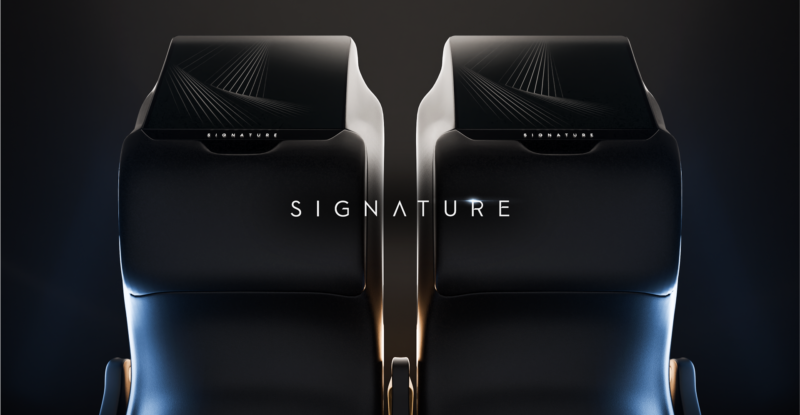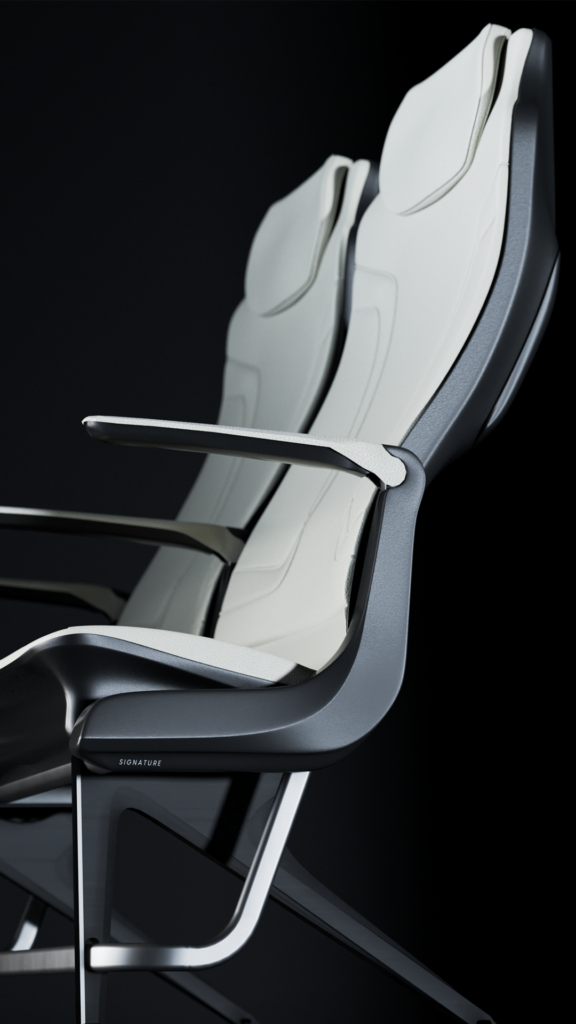HAMBURG — If it feels like it’s been a while since we’ve had a properly futuristic economy class seat concept, the hidden back rooms of the enormous Safran Seats stand at this year’s Aircraft Interiors Expo were ready to surprise and delight. Inside sat the firm’s Signature concept seat, a sinuous white sci-fi monolith that virtually promised advanced technological comfort just by its look.
As the noise-reducing door to the room closed, the sensory overload of the bustling show was blessedly reduced to a mere whisper. There, Safran Seats was showing three rows of seats: two rows of two and a row of three behind.
They were curvy and white, with visible back padding to add support and comfort. On the seatbacks was a massive screen, and it was a square rather than the usual rectangle. Without pulling out the measuring tape, the screen would probably be around 13-15 inches of diagonal sizing if it were rectangular, so it measured a good bit more than that in reality.
As I sat down, the cushion itself felt supremely comfortable (Safran says it’s a hammock design, which is among the best for weight distribution and comfort). It features Stimulite — a supportive honeycomb elastomer material manufactured by Supracor and used on, among others, fighter pilot seats and the economy class cabin of Swiss’ Boeing 777-300ER — on top, spreading out the load and making it extremely comfortable.
There are tilting headrests, contoured backrests and, crucially, a slide-forward design that avoids reclining backwards into the space of the passenger behind.
Safran calls Signature “a new development in the field of aircraft seats, which guarantees personal space for each passenger through a patented, fixed pre-set backrest architecture and is adjustable for different body types.”
Slide-forward seats in economy sound like a great idea, of course: no more worrying about impinging upon the person behind for the conscientious, and no more being impinged upon either — a major source of onboard passenger conflict in much of the world, especially where cultures and norms around personal space might clash.
For Signature, the recline is a full bucket tilt, giving a sort of zero-G-light experience, which is really incredible for economy: it felt almost as supportive as an decent kinematic premium economy class product at seat and backrest level.
Of course, the fixed seatback and sliding forwards mechanism means that the seatback doesn’t pivot forwards, and thus you don’t have the shin clearance that you might expect from recent economy class seats. (Most fully featured economy class seats today see the horizontal supports moved upwards and forwards to add leg space.)
Overall, with recline at 33″, it’s mostly fine, but one imagines that as airlines aim for 31″ it will serve taller passengers less well. Pitched at 33”, your 6’2” aviation journalist did hit a fair bit of shin clearance issue, but this is still at concept stage and there is clearly potential to adopt some of the newer structural changes within the segment to Signature.
There’s also potential to consider the non-recline advances of the seat in the context of the growth in the market for pre-reclined seats, and the problem could disappear in order to carve out additional shin clearance.
The rest of the seat, though — the massive screen, the Stimulite cushioning, the sculpted back support, the zero-G-light slide — is excellent. Whichever of these elements Safran pull from Signature for a future industrialised product, it’ll be positive news for passengers.
Related Articles:
- Southwest, Recaro unveil customised R2 seats for future 737s
- Mirus certifies ultra-lightweight 6.9kg/pax Kestrel slimline
- Designing for versatility: Safran Seats talks Z-series PaxEx
All images credited to Safran Seats












